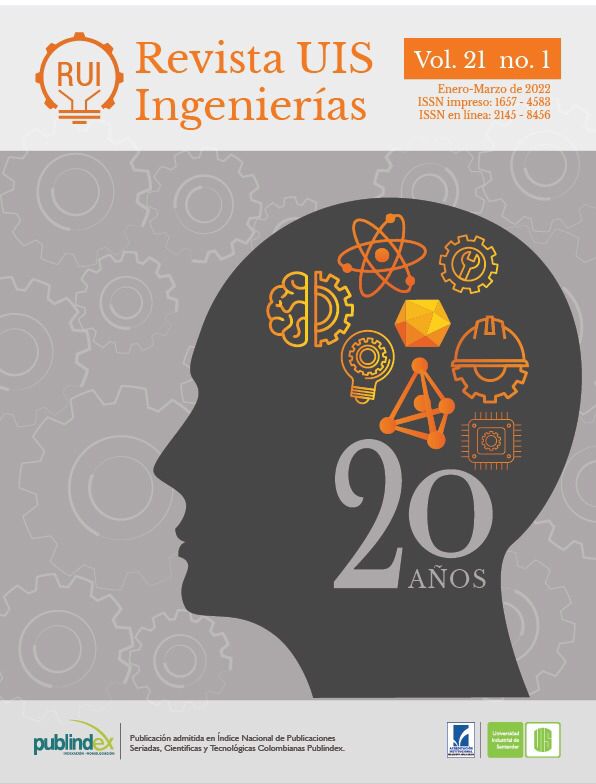Design of a computational tool for thermodynamic analysis of Otto type internal combustion engines
Published 2021-09-24
Keywords
- internal combustion engine,
- thermodynamic analysis,
- transient behavior,
- Otto cycle,
- Quarry
- heat transfer,
- dragged behavior,
- chamber pressure,
- thermal efficiency,
- Python ...More
How to Cite
Copyright (c) 2021 Revista UIS Ingenierías

This work is licensed under a Creative Commons Attribution-NoDerivatives 4.0 International License.
Abstract
A complete description of the thermodynamic behavior of an Otto cycle engine is obtained in terms of shaft rotation angle by a Python code. From results, indicators of high technical relevance are calculated, including effective pressure, specific break power, specific fuel consumption and volumetric efficiency. The proposed transient model solves transient mass and energy balances including compressible flow through the valves and combustion speed. The implemented code is validated by comparing numerical results with experimental measurements of an engine operating without combustion stage and at constant angular speed. By using the developed method, more conservative and realistic results are found for, among other indicators, thermal efficiency, volumetric efficiency and effective average pressure, and it is possible to predict the thermodynamic behavior of Otto cycle engines in an accurate and efficient way.
Downloads
References
[2] F. Taylor, The Internal-Combustion Engine in Theory and Practice, 2nd ed., vol. I. Massachusetts, MA, USA: The MIT Press, 1985.
[3] W. W. Pulkrabek, Engineering fundamentals of the internal combustion engine, 2nd ed. University of New Jersey, NJ, USA: Prentice-Hall, 2003.
[4] A. E. Figueiredo et al., “Computer Simulation of an Internal Combustion Engine”, trabajo de maestría, University of Maryland, Baltimore, MD, USA, 2008.
[5] W. M. Ambrós et al., “Experimental analysis and modeling of internal combustion engine operating with wet ethanol”, Fuel, vol. 158, pp. 270-278, 2015, doi: https://doi.org/10.1016/j.fuel.2015.05.009.
[6] A. Barjaneh, H. Sayyaadi, “A new closed-form thermodynamic model for thermal simulation of spark ignition internal combustion engines”, Energy Convers. Manag., vol. 105, pp. 607-616, 2015, doi: https://doi.org/10.1016/j.enconman.2015.08.008.
[7] M. M. Nunes, D. Faria, J. P. Vargas, M. Bueno, S. M. M. Elmassalami, C. R. Pereira, “Thermodynamic simulation model for predicting the performance of spark ignition engines using biogas as fuel”, Energy Convers. Manag., vol. 149, pp. 1096-1108, 2017, doi: https://doi.org/10.1016/j.enconman.2017.06.045.
[8] M. J. Abedin, H. H. Masjuki, M. A. Kalam, A. Sanjid, S. M. A. Rahman, B. M. Masum, “Energy balance of internal combustion engines using alternative fuels”, Renew. Sustain. Energy Rev., vol. 26, pp. 20-33, 2013, doi: https://doi.org/10.1016/j.rser.2013.05.049.
[9] A. Alagumalai, “Internal combustion engines: Progress and prospects”, Renewable and Sustainable Energy Reviews, vol. 38, pp. 561-571, 2014, doi: https://doi.org/10.1016/j.rser.2014.06.014.
[10] N. Cantera Developers, “Cantera”, 2019. [En línea]. Disponible en: https://cantera.org/.
[11] Python-Software-Foundation, “Welcome to Python.org,” 2001. [En línea]. Disponible en: https://www.python.org/.
[12] A. Lavine, D. D. Frank Incropera, T Bergman, P. Dewitt, Fundamentals of heat and mass transfer, 7th ed. USA: Jhon Wiley & Sons, 2011.
[13] O. Spitsov, “Heat transfer inside internal combustion engine: modelling and comparison with experimental data”, treabajo de maestría, Lappeenranta University of Technology, Finlandia, 2013.
[14] The-SciPy-community, “scipy.integrate.odeint — SciPy v1.3.0 Reference Guide”, 2008. [En línea]. Disponible en: https://docs.scipy.org/doc/scipy/reference/generated/scipy.integrate.odeint.html.
[15] The_SciPy-community, “scipy.integrate.solve_ivp — SciPy v1.3.0 Reference Guide”, 2008. [En línea]. Disponible en: https://docs.scipy.org/doc/scipy/reference/generated/scipy.integrate.solve_ivp.html.
[16] E. Garrido, N. Fonseca, J. Casanova, “Estudio de combustión de bioetanol y gasolina 95 en un motor CFR con AVL Boost”, trabajo de grado, Universidad Politécnica de Madrid, 2016.
[17] A. Mohammadi, M. Yaghoubi, M. Rashidi, “Analysis of local convective heat transfer in a spark ignition engine ☆”, Int. Commun. Heat Mass Transf., vol. 35, pp. 215-224, 2008, doi: https://doi.org/10.1016/j.icheatmasstransfer.2007.06.008

